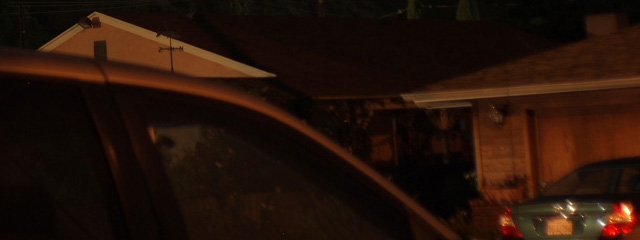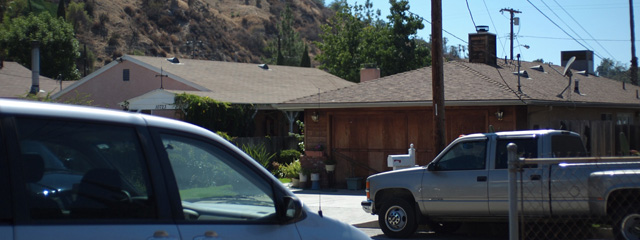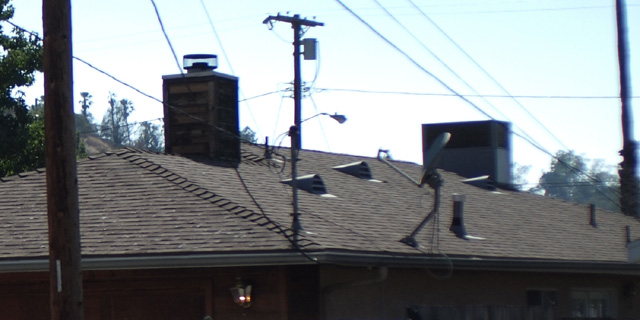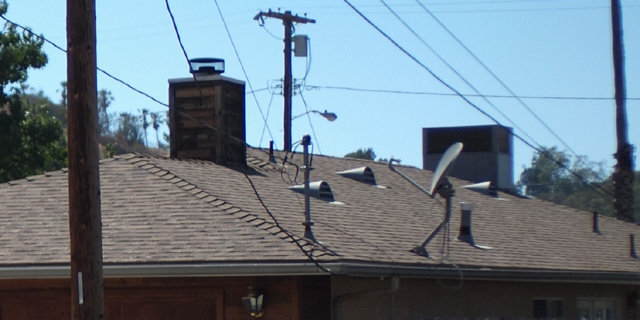Radial Blur with Rangfinder Lenses on M4/3 Cameras
Influence of Marginal Ray Angle to Anti Aliasing Filter on Off-Axis Image Quality.
Jeffrey R. Charles.
Copyright 2012 Jeffrey R. Charles All Rights Reserved.
URL: http://www.versacorp.com/vlink/jcart/radblr12.htm
Summary:
In recent years, I had to switch from a digital SLR to a camera having a high resolution EVF, due to gradually losing the ability to accurately focus an SLR, and also because a smaller and more portable camera system was desirable. For best results in compositions requiring some thought, I've always preferred manual focus.
I ultimately decided on an Olympus E-P series camera with an EVF attachment that can be tipped up for low and high angle phtography. The shallow back focus of Micro 4/3 cameras made compact rangefinder lenses the obvious choice for manual focus use, since they will retain a focus setting even when the camera is powered off and on. Even better, some rangefinder lenses have high performance at very fast f/ratios.
However, some unpleasant surprises were in store concerning the use of such rangefinder lenses on my Micro 4/3 camera. These surprises would not come to light until after I had made a significant investment in the related photo gear.
Through observation and testing, it was determined that off-axis performance of a fast f/ratio wide angle to moderate focal length non-retrofocus rangefinder lens is degraded on certain Micro 4/3 digital cameras when the marginal rays intercept the image sensor cover glass at a larger angles from perpendicular to the focal plane.
Therefore, a longer distance from the lens exit pupil to the focal plane usually results in better off-axis performance.
The image is usually degraded to a far greater degree than can be explained by lens aberrations alone. The predominant image flaw is off-axis radial blur extending inward from a highlight toward the center of the image. Performance improves when the angle of marginal rays is decreased, as can be accomplished by stopping down the lens aperture. However, one does not acquire a fast f/ratio lens for the purpose of only using it stopped down.
For a number if reasons, I began to suspect that the primary cause of this is the camera's Anti Aliasing (AA) filter, otherwise known as an optical low pass filter. I later researched the matter and found that others had come to similar conclusions [4]. Some camera manufacturers may have realized this as well [5], since a few newer digital cameras, including some from Nikon and Leica, offer either a weak AA filter, or no AA filter at all.
Defining the Problem
Off-axis performance issues that occur when short focal length rangefinder lenses are used on certain digital cameras are an anomaly of the utilized digital cameras, and has little to do with the quality of the lens. Instead, the angle the marginal rays intercept the sensor cover glass (and AA filter) determine the size of the useful field in the sensor format.
This was first observed when using a Contax G Zeiss (CZ) 35mm f/2.0 Planar lens on an Olympus E-P2 Micro 4/3 camera. The Contax Zeiss 35mm f/2 Planar is an good lens, as demonstrated by its MTF plots [1], testing, and even more so by images taken with a camera having a weak AA filter, such as a Sony NEX-3. Therefore, my impression is that the AA filter in my E-P1 and E-P2 cameras is causing the blur problem with images from this lens. This lens has to be stopped down past f/4 before the camera will provide an image with acceptable edge sharpness with it.
Before I began to suspect the camera AA filter, I tried other short focal length rangefinder lenses on the Olympus E-P1 and E-P2 cameras and experienced similar poor results. Other lenses were tried since I am somewhat heavily invested in Micro 4/3, partly because the Olympus EVF attachment eyepiece tips up to comfortably view astronomical objects when they are near zenith in astrophotography, or to photograph objects from near ground level.
Zeiss specifications for the 35mm f/2 CZ Planar [1] indicate that the exit pupil is 27.7mm in front of last lens Vertex (which is 22.6mm from the focal plane), for 50.3mm from the focal plane, with an apparent diameter of 24.9mm. The secondary principal plane is 12.5mm in front of last lens vertex, for 44.1 from the focal plane. The secondary principal plane location (when specified, or to the degree it can be measured easily) is what is used in a table below, though it is possible that referencing to the position of the exit pupil may be more appropriate.
Off-axis images with the E-P2 when using a different lens, the Voigtlander-Cosina (VC) 28mm f/2 Ultron, exhibited even more radial blur at a given f/ratio, but the lens itself does not have significant enough aberrations to even begin to explain this degree of blur. This lens has to be stopped down past f/5.6 before edges of the image are even acceptable on the E-P2. Used wide open, the radial blur exceeds 13 pixels at the edge of the image. The corners are even worse. This means that the edges and corners of of a 12 MP digital image actually have less edge and corner resolution than an ordinary SD video frame. Kind of poor.
The 28mm f/2 Ultron lens also just happens to have the largest rear cell diameter and longest rear cell protrusion distance that can be tolerated with a Micro 4/3 camera. Specifically, the VC 28mm f/2 lens has a 29.51 mm diameter rear cell that protrudes 13.26 mm behind its Leica M lens mount plane.
The Olympus E-P2 appears to tolerate VC 40mm f/1.4 Nokton better than other short focal length, fast f/ratio lenses tested to date. This lens will provide a sharp image over most of the frame at f/3.3, even though the marginal ray angle is over 17 degrees from perpendicular to the focal plane near the edge of the frame.
One lens that hasn't been tested is the Zeiss 35mm f/2.0 Biogon ZM [2], mostly due to the cost of obtaining one. It would almost be cheaper to change camera systems. However, if the camera did not exhibit objectionable radial blur with this lens, it could replace all of the other referenced lenses of similar focal length.
A Nikon retrofocus 35mm f/2 SLR lens does not exnibit the off-axis blurring problem on an Olympus E-P2. However, this lens is not as compact as the rangefinder lenses when the size of the adapter is considered. Also, it has not provided as much contrast and color saturation as any of the above rangefinder lenses, including control of flare.
In addition, it is desirable to keep the physical size and weight of a camera system reasonable, partly for medical reasons. I also want to stay with something that fits Leica M because I've gradually lost the ability to accutately focus an SLR camera [3] unless I take a lot of time doing it, so I'm transitioning mostly to Leica M compatible lenses for 35mm film photography, also using the lenses on my Olympus digital cameras. Affording even a good a Leica M camera is another story.
Examples of Radial Image Blur
These examples of off-axis radial image blur were taken with an Olympus E-P2 camera, through a Voigtlander (VC) 28mm f/2.0 Ultron lens, with the aperture set between f/2.0 and f/2.4.
© Copyright 2012 Jeffrey R. Charles. All Rights Reserved.
 |
| The radial blur extends from highlights toward the center of the image, regardless of the lens used. This crop from the lower right quadrant of a night image shows the blur extending toward the upper left from highlights on the back of the car at lower right. The blur is even more obvious on backlit objects.
|
 |
| This image shows the entire width of the image from which the next two examples of radial blur will be cropped. The points of interest will be the right sides of the palm tree and the roof air conditioner at the extreme right of the picture, the wires from the power pole transformer, left of that, and the green tree near center. The camera is an Olympus E-P2 and the lens is a Voigtlander (VC) 28mm f/2.0 Ultron.
|
 |
| This image is cropped from the right side of the above scene. Here, the lens is focused near infinity, between the distance of the green tree at the left and the palm tree at the extreme right. The blur is more than 13 pixels wide on the right side of the palm tree trunk, and almost as wide on the right side of the roof air conditioner. The blur is even wider at the corners. However, the blur width decreases toward the center of the original picture, where it is absent on the green tree at left. Note that the palm tree at right is in focus, but light from the background sky is blurred toward the center, and thus over the palm tree trunk image. The exposure at ISO 100 is 1/4000 sec at f/2.4.
|
 |
| In this image, the lens is focused slightly in front of the palm tree, with best focus on the foreground telephone pole. Setting the focus closer reduces the width of the blur at the palm tree trunk by almost half, at the expense of some defocus on the green tree at left (which is near the center of the original picture) and objects beyond it. The exposure at ISO 100, 1/4000 sec at f/2.0. In spite of the wider f/2 aperture, the change in focus reduced the off-axis blur to less than that of the image taken at f/2.4.
|
Other Considerations
Of the above lenses, the Contax G Zeiss 35mm f/2 Planar focuses closest, focusing down to 0.5m. However, the none of the focusing adapters for Contax G lenses are quiet enough to take movies when using the on-camera microphone. Other lenses noted above are Leica M mount and focus quietly, but these only focus down to 0.7m, parly because that is the close focus distance supported by the Leica rangefinder.
It would be desirable to modify the other rangefinder lenses to focus down to 0.5m. However, since the forward longitudinal motion of the rangefinder cam exceeds the forward motion of the optics when the lens is focused close, rear parts of the lens barrel assembly in these lenses would require an additional ~2mm of clearance from the rangefinder cam if rangefinder coupling is to still be retained after the close focus distance of the lens has been modified. This clearance is required to accommodate additional relative motion of the rangefinder cam with respect to the lens optics when the lens is focused closer.
The helical focus threads of the lens would also requre an additional 40 percent of margin to remain engaged at a 0.5m close focus distance. Most lens threads have considerably more margin than this, though the rangefinder cam threads may not have as much margin.
Such close focus modifications would obviously be with the recognition that a Leica rangefinder camera won't track the focusing cam to closer than 0.7m, but that would not be a problem because the closer focus distance would only be utilized for digital imaging.
A Leica M compatible digital camera would be desirable, but for now, cost and motor noise are the main issues with these. The older Epson R-D1 [6] (which is manually wound and thus lacks the objectionable motor noise) would be the ticket, particularly if a new version was offered with 12 to 16 MP (but not more than that), with menu settings that survived powering the camera off and on, and frame lines for up to 90mm lenses.
Specific Applications.
I currently use 3 different rangefinder lenses of relatively similar focal lengths to get different types of pictures:
- A VC 28mm f/2 Ultron is used for close range movies (focus is quiet).
- Contax G Zeiss 35mm f/2 Planar is for still images (adapter too noisy for movies)
- VC 40mm f/1.4 Nokton is for low light movies and stills (it's better at f/2 than the 28mm)
To fully appreciate why different lenses are used for various applications, it is useful to look at a few more of the downsides revealed in the trade space. Each of the lenses have different shortcomings that keep it from being the only lens in this focal length range I'd want to use use:
- VC 28mm f/2.0 Ultron: Focus shift, field curvature, and CA limit maximum useful f/ratio to f/3.3 for a good image, and f/4.8 for a sharp full frame image.
- CZ 35mm f/2.0 CG Planar: Spherical aberration limits the maximum useful f/ratio to 2.8 for a good image, and f/4.5 for a really sharp full frame image.
- ZM 35mm f/2.0 Biogon ZM: Has not been acquired or tested.
- VC 40mm f/1.4 Nokton: Spherical and CA limit max useful f/ratio to ~f/2.8 for a good image, and f/3.3 for a really sharp full frame image.
The above f/ratios are somewhat pessimistic compared to actual imaging of many real world subjects because the maximum f/ratios indicated are what will theoretically provide an image that is almost limited by the camera pixel size, which is quite a good image. In reality, all of the above lenses will capture acceptable images (even good images) when stopped down only half a stop below maximum aperture. This is particularly true for HD movies.
However, When the same lenses are used on an Olymous E-P1 or E-P2 Micro 4/3 camera, the maximum useful f/ratios are often reduced by more than an additional f-stop slower than what is shown above for 12 MP images, due to off-axis radial image blurring.
The VC 40mm f/1.4 Nokton would be adequate (other than for the AA filter issue) if it was a 35mm focal length. Most compositions with the 40mm on the Micro 4/3 format are a little tight, which is why a 35mm or slightly shorter focal length is preferred. The VC 35mm f/1.4 has not been considered an option because it is reputed (and shown in test images on the web) [8] to have more focus shift and CA than the 28mm f/2, and its short physical length probably means that its exit pupil is relatively close to the focal plane, which would increase the marginal ray tilt angle at the image edge.
The Zeiss 35mm f/2.0 Biogon ZM [7] could replace all 3 of the above lenses on my digital cameras if the AA filter is not as much of an issue with it. It's MTF [2] is even better than the Contax G Zeiss 35mm f/2 lens, but the marginal ray angle will probably have a greater influence on the off-axis image with my Micro 4/3 cameras than the MTF of the lens itself.
Tests illustrating limitations of selected lenses when used on an Olympus E-P2.
The table below shows f-stop versus maximum useful field diameter in millimeters when the three listed lenses are used on Olympus E-P1 and E-P2 micro 4/3 digital cameras. The table also shows the angle at which the extreme marginal rays intercept the camera Anti-Aliasing (AA) filter at the outer boundary of the useful field. The AA filter is suspected of being what severely reduces off-axis performance, since the image begins to blur radially outside of the noted field diameters.
The field diameter is defined here as the area beyond which radial blurring becomes more significant than the lens aberrations to an obvious degree. This is admittedly a little subjective, but it still helps quantify the problem by illustrating that the size of the field having acceptable resolution is very small in relation to the image sensor, unless the lens is stopped down considerably. In the worst case (full aperture with a 28mm f/2 lens), radial blur near the edge of the image sensor exceeds 13 pixels, making the edge resolution of my 12 MP digital camera worse than that of an ordinary SD video frame.
The following table shows the useful field diameter versus focal length and f/ratio when the listed lenses are used on an Olympus E-P1 or E-P2 camera. The values were obtained through tests in which different subjects were imaged. When possible, the same subjects were imaged under the same conditions with all of the lenses. Subjects include a daytime landscape scene, a array of newspapers, and stars.
Table 1.
Useful Field Diameter Versus Focal Length and f/ratio (Limited by Anti Alias Filter)
Dimensions in millimeters. Aperture radius accounts for any clipping* by barrel.
Distances from secondary principal plane to FP are estimates unless data available.
Data arranged per the following colums. Notes at right may indicate test subjects.
Lens Details / Meas.FL./ SecPP-FP/ fstop/ Aper.Rad/ SharpFldDia./ MRayAngle/ Notes
28mm f/2.0 VC Ultron / 28.0mm / 32.8 / 2.0 / 5.6* / 6.6 / 15.18 deg / St(NP=10FD)
28mm f/2.0 VC Ultron / 28.0mm / 32.8 / 2.4 / 4.7* / 7.6 / 14.53 deg / Landscape
28mm f/2.0 VC Ultron / 28.0mm / 32.8 / 2.8 / 5.0r / 8.4 / 15.67 deg / Ls(NP=11.5)
28mm f/2.0 VC Ultron / 28.0mm / 32.8 / 4.0 / 3.5r / 10.0 / 14.53 deg / Jp(NP=13FD)
Typ. max. marginal ray angle without obvious radial blur with this lens: 15.0 deg.
35mm f/2.0 Contax GZ / 35.1mm / 44.1 / 2.0 / 7.4* / 10.0 / 15.70 deg / (NP=9.5FD)
35mm f/2.0 Contax GZ / 35.1mm / 44.1 / 2.8 / 6.2r / 11.2 / 14.98 deg / Jupiter, NP
35mm f/2.0 Contax GZ / 35.1mm / 44.1 / 4.0 / 4.4r / 15.6 / 15.46 deg / (J=11.2FD)
35mm f/2.0 Contax GZ / 35.1mm / 44.1 / 4.8 / 3.6r / 18.4 / 16.19 deg / Nwsppr, Ls
Typ. max. marginal ray angle without obvious radial blur with this lens: 15.6 deg.
35mm f/2.0 Biogon ZM / Not acquired or tested.
40mm f/1.4 VC Nokton / 41.0mm / 41.8 / 1.4 / 13.9* / 0.6 / 18.76 deg / Newspaper
40mm f/1.4 VC Nokton / 41.0mm / 41.8 / 1.7 / 10.6* / 5.7 / 17.84 deg / Stars, NP
40mm f/1.4 VC Nokton / 41.0mm / 41.8 / 2.0 / 10.0r / 8.4 / 18.76 deg / Jupiter
40mm f/1.4 VC Nokton / 41.0mm / 41.8 / 2.4 / 8.3r / 10.8 / 18.15 deg / Landscape
40mm f/1.4 VC Nokton / 41.0mm / 41.8 / 2.8 / 7.1r / 11.4 / 17.03 deg / Jupiter
40mm f/1.4 VC Nokton / 41.0mm / 41.8 / 3.3 / 6.1r / 14.2 / 17.53 deg / Jupiter
40mm f/1.4 VC Nokton / 41.0mm / 41.8 / 4.0 / 5.0r / 16.4 / 17.53 deg / Jupiter
Typ. max. marginal ray angle without obvious radial blur with this lens: 17.9 deg.
Results:
* Minimum calculated critical ray angle (accounts for aperture clipping) is 14.5 deg.
** However, if no highlights that make blur obvious are imaged, minimum is 15.7 deg.
* Maximum calculated critical ray angle (based on FL/f-stop) is 18.8 deg (40mm lens).
* The aperture is clipped by lens barrel on Micro 4/3 format only if indicated by *.
* In general, different types of subjects made less than a 1.8 degree difference
in the marginal ray angles that determined useful field sizes.
* For the above, the marginal ray having the greatest angle from perpendicular to
the focal plane is at an angle of approximately: InvTan((d+r)/f)
..where d is the off-axis Distance, a is the aperture Radius, and f is the
effective optical distance from the lens iris to the focal plane.
Notes and conclusions: Based on microscopic visual examination of axial and off-axis performance of the lenses in the absence of digital camera anti-aliasiing (AA) filter, it has been shown that the lenses do not have aberrations even remotely severe enough to cause the blur that limits the field size to values noted above. When these lenses are used on an Olympus E-P1 or E-P2 camera, the AA filter (assumed to be the problem, based on the above) generally prevents good off-axis results unless the the lenses are stopped down to between f/5.6 and f/8, which are an even slower f/ratios than Micro 4/3 kit zoom lenses.
Table 2:
Relevant Micro 4/3, Leica, and Other Dimensions:
Micro 4/3 dimensions and clearances, Longitudinal from focal plane:
Shutter clearance from Focal P: 9.60~9.85 (!!!) (0.370~0.380" behind lens mount)
Back of Computar 5mm MP to FP: 10.624
C-mount thread dia clear to FP: 11.63~13.80 (for 25.4mm OD)
Clearance for 25.4~28.0mm OD: 14.48~14.93 (best case)
Clearance for 28.0~29.51mm OD: 14.68 from focal plane (conservative)
Back of Micro 4/3 Lens Flange: 15.40
Metal >29.51 (1.162") OD Clear: 15.70 (19.25-M4/3 lens bayonet depth-0.75mm=3.55)
Lens Flange - Focal Plane Dist. 19.25
Micro 4/3 Diameters:
Contact ring inner clearance: 29.51 (1.162") Approximate
Bayonet mount cylinder OD: TBD
Leica 90mm f/2.8 Col. Elmar OD: 52.0
Leica-M4/3 Adapter base OD: 55.0mm
Maximum OD to clear tripod hd: 62.0mm
Oly. 17mm f/2.8 Pancake L. OD: TBD
Pan. 20mm f/1.7 Pancake L. OD: TBD
Focal Plane Dimensions: 17.3 x 12.98mm (~22 diagonal incl. centering error)
Critical Ray Angle, Range for Olympus E-P2 Minimum: 14.5 to 18.8 deg.
LeicaM-Mic4/3 Adapt (8.55 theo) 8.623 Best real depth for infinity stop (0.3395")*
Leica M, Mount to Fr. Shut. Ct. 9.80 Conservative, (18.00mm (0.710") from lens mt)
Leica M, Mount to Meter Cell 10.15 Axial, (17.65mm (0.695") from lens mount)
Leica M, Mount to Shutter Baf. 10.35 12.0 OA, (17.45mm (0.687") from lens mount)
Leica M, FP to RF Wheel Screws 11.93 12.5 OA, (15.87 (0.625") from lens mount)
Leica M, Rear Cell 28/2 Ultron 14.54 (Projects 13.26 behind lens mount; OD=29.51)
Leica M Mount: Bayonet to FP 27.80 Adapter ~8mm long, so M43 <19.8.
Leica M39 Thr.: M39-26tpi to FP 28.80
Leica CL, Safe rear protrusion 15.87~17.45mm (0.625~0.687")
* Note: Best adapter depth depends on any variation in lens mount to focal plane
distance between Micro 4/3 cameras. This distance appears to be well controlled in
samples obseverd to date. However, a little (~0.05mm) variation has been detected.
References:
- Carl Zeiss, Planar (R) T* 2/35 Contax (R) G mount lens data sheet, 2000.
- Carl Zeiss, Biogon T* 2/35 ZM (Leica M mount) lens data sheet, date TBD.
- Charles, Jeffrey R.; Review of Samyang 8 mm f/3.5 Proportional Projection Ultra-wide Angle Lens, 19 Octover, 2009, Draft Rev. 0.5, 4 Dec. 2009. www.versacorp.com
- dpreview forums, Re: AA filter on NEX-7, but none on NEX-5N?, 2012.
- Petersen, Bjorn, Discerning the Differences between the Nikon D800 and D800E, 16 Mar. 2012
- Reid, Sean; Fast Lenses for the Epson R-D1, Publication date TBD;
http://www.luminous-landscape.com/reviews/lenses/fastlensreview.shtml
- Rockwell, Ken; Review of Zeiss 35mm f/2.0 Biogon T* ZM lens.
- Reference (TBD) for focus shift in VC 35mm f/1.4 lens.
All aspects of this material (with exception of Contax G Zeiss 35mm f/2 lens specifications) Copyright 2012 Jeffrey R. Charles, All Rights Reserved.
Originated: 120829. Published at Versacorp.com: 120717.
Go to EclipseChaser Home Page
Go to Versacorp Home Page



